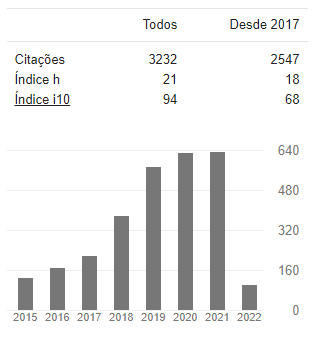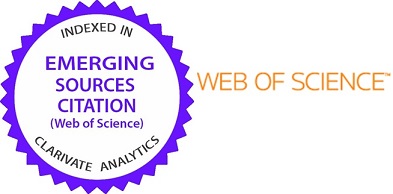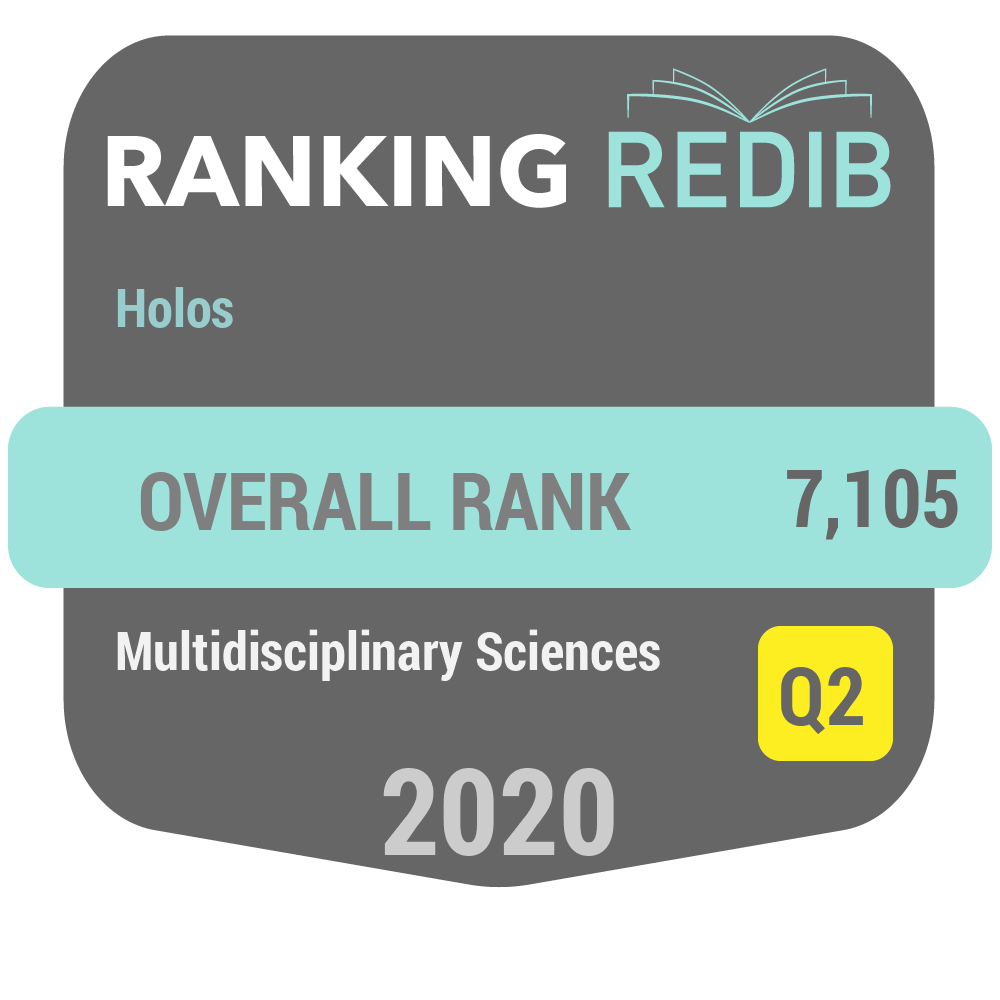SÍNTESE VERDE DE NANOPARTÍCULAS ANTIOXIDANTES FEITAS COM PRATA E POLISSACARÍDEOS SULFATADOS DA ALGA Gracilaria birdiae
DOI:
https://doi.org/10.15628/holos.2021.11100Palavras-chave:
Alga vermelha, nanopartículas metálicas, agaranas, quelação férrica, galactanas sulfatadasResumo
Polissacarídeos sulfatados (PSs) da alga vermelha comestível Gracilaria birdiae possuem atividade antioxidante. Trabalhos anteriores mostram que PSs, quando em forma de nanopartículas de prata (NpsAg), apresentam melhor atividade antioxidante do que em sua forma original. Contudo, não há dados referentes a NpsAg sintetizadas com PSs de G. birdiae. Portanto, NpsAg sintetizadas a partir dos PSs de G. birdiae foram obtidas e avaliadas como agentes antioxidantes. Foram realizadas a detecção e a medição de tamanho das NpsAg por dispersão de luz dinâmica (DLS). O extrato de PS foi avaliado quanto a sua capacidade redutora pelo teste de capacidade antioxidante total (CAT). A capacidade antioxidante das NpsAg e dos PS também foi determinada pelo teste de quelação férrica. O teor de proteínas e de açúcar foi determinado por espectrofotometria. Os PS apresentaram CAT, e isso habilitou-os para a síntese de NpsAg. As NpsAg apresentaram tamanho médio de 117,6 nm. Nenhuma contaminação proteica foi encontrada nos PSs e nas NpsAg. O teor de açúcar na suspensão de NpsAg (55,7%) foi superior ao encontrado na solução de PSs (49,7%). A suspensão com NpsAg apresentou uma atividade quelante de ferro 25% maior que a solução de PSs. Os resultados mostraram que os PSs de G. birdiae, sob a forma de nanopartículas, tiveram a sua atividade quelante de ferro potencializada, indicando que as nanopartículas de prata podem ser objeto de futuros estudos para identificar seu potencial como agentes antioxidantes em diferentes aplicações.
Downloads
Referências
Ahamed, M., Alsalhi, M. S., Siddiqui, M. K. J. (2010) Silver nanoparticles applications and human health. Clinica Chimica Acta, 411, 1841-1848. Doi.org/10.1016/j.cca.2010.08. DOI: https://doi.org/10.1016/j.cca.2010.08.016
Ahmad, A., Mukherjee, P., Senapati, S., Mandal, D., Khan, M., Kumar, R., Sastry, M. (2003). Extracellular biosynthesis of silver nanoparticles using the fungus Fusarium oxysporum. Colloids and Surfaces B: Biointerfaces, 20, 313–318. Doi.org/10.1016/S0927-7765(02)00174-1. DOI: https://doi.org/10.1016/S0927-7765(02)00174-1
Akmaz, S., Akmaz, S., Dilaver, E., Ad, J., Yasar, M., Erguven, O. (2013). The effect of Ag content of the chitosan-Silver nanoparticle composite material on the structure and antibacterial Activity. Advances in Materials Science and Engineering, 12–18. doi.org/10.1155/2013/690918. DOI: https://doi.org/10.1155/2013/690918
Amorim, M. O. R., Gomes, D. L., Dantas, L. A., Chiquetti, S. C., Viana, R. L. S., Lima, J. A., Costa, L. S., Rocha, H. A. O. (2016). Fucan-coated silver nanoparticles synthesized by a green method induce human renal adenocarcinoma cell death. International Journal of Biological Macromolecules, 93, 57-65. Doi.org/10.1016/j.ijbiomac.2016.08.043. DOI: https://doi.org/10.1016/j.ijbiomac.2016.08.043
Apak, R. (2019). Current issues in antioxidant measurement. Journal of Agricultural and Food Chemistry, 67, 9187-9202. Doi.org/10.1021/acs.jafc.9b03657. DOI: https://doi.org/10.1021/acs.jafc.9b03657
Asmathunisha, N., Kathiresan, K. A review on biosynthesis of nanoparticles by marine organisms. (2013). Colloids and Surfaces B: Biointerfaces, 103, 283-287. Doi.org/ 10.1016/j.colsurfb.2012.10.030. DOI: https://doi.org/10.1016/j.colsurfb.2012.10.030
Ayala, A., Muñoz, M. F., & Argüelles, S. (2014). Lipid peroxidation: production, metabolism, and signaling mechanisms of malondialdehyde and 4-hydroxy-2-nonenal. Oxidative Medicine and Cellular Longevity, 2014, 1-31. Doi.org/10.1155/2014/360438. DOI: https://doi.org/10.1155/2014/360438
Azizi, S., Namvar, F., Mahdavi, M., Ahmad, M. B., Mohamad, R. (2013). Biosynthesis of silver nanoparticles using brown marine macroalga, Sargassum muticum aqueous extract. Materials, 6, 5942-5950. Doi.org/10.3390/ma6125942. DOI: https://doi.org/10.3390/ma6125942
Barros, J. A. C., Nascimento, D. L. A., Silveira, A. C. R., Silva, R. K., Gomes, D. L., Melo, K. R. T., Almeida-Lima, J., Camara, R. B. G., Silva, N. B., Rocha, H. A. O. (2018). Evaluation of the antioxidant activity and protective action of the seaweed Gracilaria birdiae. Oxidative Medicine and Cellular Longevity, 2018, 1-12. Doi.org/10.1155/2018/9354296. DOI: https://doi.org/10.1155/2018/9354296
Brito, T. V., Neto, J. P., Prudêncio, R. S., Batista, J. A., Júnior, J. S., Silva, R. O., Franco, A. X., Aragão, K. S., Soares, P. M., Souza, M. H., et al. (2014). Sulfated-polysaccharide fraction extracted from red algae Gracilaria birdiae ameliorates trinitrobenzenesulfonic acid-induced colitis in rats. Journal of Pharmacy and Pharmacology, 66, 1161–1170. Doi.org/10.1111/jphp.12231. DOI: https://doi.org/10.1111/jphp.12231
Coradeghini, R., Gioria, S., García, C. P., Nativo, P., Franchini, F., Gilliland, D., Ponti, J., Rossi, F. (2013). Size-dependent toxicity and cell interaction mechanisms of gold nanoparticles on mouse fibroblasts. Toxicology Letters, 217, 205–216, 2013. Doi.org/ 10.1016/j.toxlet.2012.11.022 DOI: https://doi.org/10.1016/j.toxlet.2012.11.022
Dietrich, C. P., Dietrich, S. M. (1976). Electrophoretic behaviour of acidic mucopolysaccharides in diamine buffers. Analytical Biochemistry, 70, 645-647. Doi.org/10.1016/0003-2697(76)90496-6. DOI: https://doi.org/10.1016/0003-2697(76)90496-6
Dipankar, C., Murugan, S. (2012). The green synthesis, characterization and evaluation of the biological activities of silver nanoparticles synthesized from Iresine herbstii leaf aqueous extracts. Colloids and surfaces. Colloids and Surfaces B: Biointerfaces, 98 (1), 112–121. doi.org/10.1016/j.colsurfb.2012.04.006. DOI: https://doi.org/10.1016/j.colsurfb.2012.04.006
Dixon, S. J., & Stockwell, B. R. (2014). The role of iron and reactive oxygen species in cell death. Nature Chemical Biology, 10, 9-17. Doi.org/10.1038/nchembio.1416. DOI: https://doi.org/10.1038/nchembio.1416
El-rafie, H. M., El-rafie, M. H., Zahran, M. K. (2013). Green synthesis of silver nanoparticles using polysaccharides extracted from marine macro algae. Carbohydrate polymers, 96(2), 403–410. doi.org/10.1016/j.carbpol.2013.03.071. DOI: https://doi.org/10.1016/j.carbpol.2013.03.071
Elsabahy, M. & Wooley, K. L. (2012) Design of polymeric nanoparticles for biomedical delivery applications. Chemical Society Reviews, 41(7), 2545-2561. Doi.org/ 10.1039/c2cs15327k. DOI: https://doi.org/10.1039/c2cs15327k
Fernandes- Negreiros, M. M. F., Machado, R. I. A., Bezerra, F. L., Melo, M. C. N., Alves, M. G. C. F., Filgueira, L. G. A., Morgano, M. A., Trindade, E. S., Costa, L. S., Rocha, H. A. O. (2017). Antibacterial, antiproliferative, and immunomodulatory activity of silver nanoparticles synthesized with fucans from the alga Dictyota mertensii. Nanomaterials, 8, 6. Doi.org/10.3390/nano8010006. DOI: https://doi.org/10.3390/nano8010006
Guiry M.D. in Guiry, M.D. & Guiry, G.M. (2021). AlgaeBase. World-wide electronic publication, National University of Ireland, Galway. http://www.algaebase.org. Acessado em 30 de março de 2021.
Gupta, S. C., Hevia, D., Patchva, S., Park, B., Koh, W., Aggarwal, B. B. (2012). Upsides and downsides of reactive oxygen species for cancer: the roles of reactive oxygen species in tumorigenesis, prevention, and therapy. Antioxidants & Redox Signaling, 16, 1295-1322. Doi.org/ 10.1089/ars.2011.4414. DOI: https://doi.org/10.1089/ars.2011.4414
Gurunathan, S., Raman, J., Malek, S. N. A., John, P. A., Vikineswary, S. (2013). Green synthesis of silver nanoparticles using Ganoderma neo-japonicum Imazeki: A potential cytotoxic agent against breast cancer cells. International Journal of Nanomedicine, 8, 4399–4413. Doi.org/ 10.2147/IJN.S51881. DOI: https://doi.org/10.2147/IJN.S51881
Hansen, J. B., Moen, I. W., & Mandrup-Poulsen, T. (2014). Iron: the hard player in diabetes pathophysiology. Acta Physiologica, 210, 717-732. Doi.org/10.1111/apha.12256. DOI: https://doi.org/10.1111/apha.12256
Hussain, S., Pal, A. K. (2008). Incorporation of nanocrystalline silver on carbon nanotubes by electrodeposition technique. Materials Letters, 62, 1874–1877. Doi.org/10.1016/j.matlet.2007.10.021. DOI: https://doi.org/10.1016/j.matlet.2007.10.021
Kremastinos, D. T., & Farmakis, D. (2011). Iron overload cardiomyopathy in clinical practice. Contemporary Reviews in Cardiovascular Medicine, 124, 2253-2263. Doi.org/10.1161/CIRCULATIONAHA.111.050773. DOI: https://doi.org/10.1161/CIRCULATIONAHA.111.050773
Li, L., Ng, T. B., Song, M., Yuan, F., Liu, Z. K., Wang, C. L., Jiang, Y., Fu, M., Liu, F. (2007). A polysaccharide-peptide complex from abalone mushroom (Pleurotus abalonus) fruiting bodies increases activities and gene expression of antioxidant enzymes and reduces lipid peroxidation in senescence-accelerated mice. Applied Microbiology and Biotechnology, 75, 863-869. Doi.org/10.1007/s00253-007-0865-4. DOI: https://doi.org/10.1007/s00253-007-0865-4
Maciel, J. S., Chaves, L. S., Souza, B. W. S., Teixeira, D. I. A., Freitas, A. L. P., Feitosa, J. P., Paul, R. C. M. (2008). Structural characterization of cold extracted fraction of soluble sulfated polysaccharide from red seaweed Gracilaria birdiae. Carbohydrate Polymers, 71, 559–565. Doi.org/10.1016/j.carbpol.2007.06.026. DOI: https://doi.org/10.1016/j.carbpol.2007.06.026
Marinho-Soriano, E., Moreira, W. S. C., Carneiro, M. A. A. (2006). Some aspects of the growth of G. Birdiae (Gracilariales, Rhodophyta) in an estuary in Northeast Brazil. Aquaculture Internacional, 14, 327-336. Doi.org/10.1007/s10499-005-9032-z. DOI: https://doi.org/10.1007/s10499-005-9032-z
Mohanraj, V. J., Chen, Y. (2006). Nanoparticles - a review. Tropical Journal of Pharmaceutical Research, 5, 561-573. Doi.org/10.4314/tjpr.v5i1.14634. DOI: https://doi.org/10.4314/tjpr.v5i1.14634
Morones, J. R., Elechiguerra, J. L., Camacho, A., Holt, K., Kouri, J. B., Ramírez, J. T., Yacaman, M. J. (2005). The bactericidal effect of silver nanoparticles. Nanotechnology, 16(10) 2346–2353. Doi.org/10.1088/0957-4484/16/10/059. DOI: https://doi.org/10.1088/0957-4484/16/10/059
Negreiros, M. M. F. (2015). Nanopartículas de prata contendo polissacarídeos sulfatados de algas: caracterização química, morfológica e identificação de suas atividades antioxidante, bactericida, antiploriferativa e imunomodulatória. Dissertação de mestrado. Programa Pós-graduação em Bioquímica, UFRN, Natal-RN.
Okafor, F., Janen, A., Kukhtareva, T., Edwards, V., Curley, M. (2013). Green synthesis of silver nanoparticles, their characterization, application and antibacterial activity. International Journal of Environmental Research and Public Health, 10(10), 5221–5238. Doi.org/ 10.3390/ijerph10105221. DOI: https://doi.org/10.3390/ijerph10105221
Oliveira, L. C. B. P., Queiroz, M. F., Fidelis, G. P., Melo, K. R. T., Camara, R. B. G., Alves, M. G. C. F., Teixeira, D. I. A., Silveira, R. F. M., Rocha, H. A. O. (2020). Antioxidant sulfated polysaccharide from edible red seaweed Gracilaria birdiae is an inhibitor of calcium oxalate crystal formation. Molecules, 25, 2055. Doi.org/10.3390/molecules25092055. DOI: https://doi.org/10.3390/molecules25092055
Pal, S., Tak, Y. K., Song, J. M. (2007). Does the antibacterial activity of silver nanoparticles depend on the shape of the nanoparticle? A study of the gram-negative bacterium Escherichia coli. Applied and Environmental Microbiology, 73(6), 1712–1720. Doi.org/10.1128/AEM.02218-06. DOI: https://doi.org/10.1128/AEM.02218-06
Pandey, S., Goswami, G. K., Nanda, K. K. (2012). Green synthesis of biopolymer-silver nanoparticle nanocomposite: an optical sensor for ammonia detection. International Journal of Biological Macromolecules, 51(4), 583-589. Doi.org/10.1016/j.ijbiomac.2012.06.033. DOI: https://doi.org/10.1016/j.ijbiomac.2012.06.033
Park, Y., Hong, Y. N., Weyers, A., Kim, Y. S., Linhardt, R. J. (2011). Polysaccharides and phytochemicals: a natural reservoir for the green synthesis of gold and silver nanoparticles. IET Nanobiotechnology, 5, 69-78. Doi.org/10.1049/iet-nbt.2010.0033. DOI: https://doi.org/10.1049/iet-nbt.2010.0033
Rodríguez-León, E., Iñiguez-Palomares, R., Navarro, R. E., Herrera-Urbina, R., Tánori, J., Iñiguez-Palomares, C., & Maldonado, A. (2013). Synthesis of silver nanoparticles using reducing agents obtained from natural sources (Rumex hymenosepalus extracts). Nanoscale Research Letters, 8(1), 318. Doi.org/10.1186/1556-276X-8-318. DOI: https://doi.org/10.1186/1556-276X-8-318
Santos, C. A., Seckler, M. M., Ingle, A. P., Gupta, I., Galdiero, S., Galdiero, M., Gade, A., Rai, M. (2014). Silver nanoparticles: therapeutical uses, toxicity, and safety issues. Journal of Pharmaceutical Sciences, 103, 1931-1944. Doi.org/10.1002/jps.24001. DOI: https://doi.org/10.1002/jps.24001
Shashoua, V. E., Adams, D. S., Volodina, N. V., Li, H. (2004). New synthetic peptides can enhance gene expression of key antioxidant defense enzymes in vitro and in vivo. Brain Research, 1024, 34-43. Doi.org/10.1016/j.brainres.2004.06.086. DOI: https://doi.org/10.1016/j.brainres.2004.06.086
Silva, R. O.; Santana, A. P., Carvalho, N. S., Bezerra, T. S., Oliveira, C. B., Damasceno, S. R., Chaves, L. S., Freitas, A. L., Soares, P. M., Souza, M. H., et al. (2012). A sulfated-polysaccharide fraction from seaweed Gracilaria birdiae prevents naproxen-induced gastrointestinal damage in rats. Marine Drugs, 10, 2618–2633. Doi.org/0.3390/md10122618. DOI: https://doi.org/10.3390/md10122618
Vanderlei, E. S. O., Araújo, I. W. F., Quinderé, A. L. G., Fontes, B. P., Eloy, Y. R. G., Rodrigues, J. A. G., Chaves, H. V., Jorge, R. J., de Menezes, D. B., Evangelista, J. S., et al. (2011). The involvement of the HO-1 pathway in the anti-inflammatory action of a sulfated polysaccharide isolated from the red seaweed Gracilaria birdiae. Inflammation Research, 60, 1121–1130. Doi.org/10.1007/s00011-011-0376-8. DOI: https://doi.org/10.1007/s00011-011-0376-8
Vasconcelos, A. G., Araújo, K. V. (2015). Polissacarídeos extraídos de algas marinhas e suas aplicações biotecnológicas: uma revisão. Revista Brasileira de Inovação Tecnológica em Saúde, 5, 27–51.Doi.org/10.18816/r-bits.v5i3.5898. DOI: https://doi.org/10.18816/r-bits.v5i3.5898
Wei, L., Lu, J.; Xu, H., Patel, A., Chen, Z., Chen, G. (2015). Silver nanoparticles: synthesis, properties, and therapeutic applications. Drug Discovery Today, 20, 595-601. Doi.org/10.1016/j.drudis.2014.11.014. DOI: https://doi.org/10.1016/j.drudis.2014.11.014
Zhang, H. Y., Yang, D. P., Tang, G. Y. (2006). Multipotent antioxidants: from screening to design. Drug Discovery Today, 11, 749–754. Doi.org/10.1016/j.drudis.2006.06.007. DOI: https://doi.org/10.1016/j.drudis.2006.06.007









































